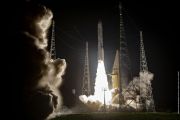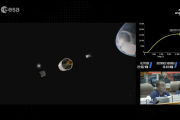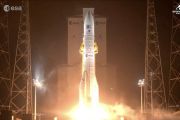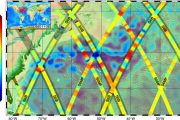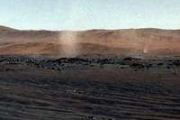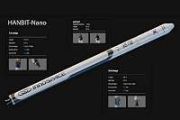
Copernical Team
Black hole collisions could help us measure how fast the universe is expanding
 A black hole is usually where information goes to disappear-but scientists may have found a trick to use its last moments to tell us about the history of the universe.
In a new study, two University of Chicago astrophysicists laid out a method for how to use pairs of colliding black holes to measure how fast our universe is expanding-and thus understand how the universe evolved, what it is
A black hole is usually where information goes to disappear-but scientists may have found a trick to use its last moments to tell us about the history of the universe.
In a new study, two University of Chicago astrophysicists laid out a method for how to use pairs of colliding black holes to measure how fast our universe is expanding-and thus understand how the universe evolved, what it is 103rd successful rocket launch breaks record
 The Long March carrier rocket family, China's backbone launch vehicle fleet, has set a new record for successful consecutive launches after a Long March 2D launch over the weekend, according to the China Aerospace Science and Technology Corp, the country's leading space contractor.
The rocket blasted off at 1:37 am Saturday from the Xichang Satellite Launch Center in Sichuan province and l
The Long March carrier rocket family, China's backbone launch vehicle fleet, has set a new record for successful consecutive launches after a Long March 2D launch over the weekend, according to the China Aerospace Science and Technology Corp, the country's leading space contractor.
The rocket blasted off at 1:37 am Saturday from the Xichang Satellite Launch Center in Sichuan province and l China launches new satellite via Kuaizhou 1A carrier rocket
 China on Tuesday successfully launched a new satellite into space from the Xichang Satellite Launch Center in Southwest China's Sichuan province.
The Chuangxin-16 satellite, developed by the Chinese Academy of Sciences, was launched at 10:36 am (Beijing Time) by a Kuaizhou 1A carrier rocket and entered the planned orbit successfully.
The satellite will mainly be used for scientific e
China on Tuesday successfully launched a new satellite into space from the Xichang Satellite Launch Center in Southwest China's Sichuan province.
The Chuangxin-16 satellite, developed by the Chinese Academy of Sciences, was launched at 10:36 am (Beijing Time) by a Kuaizhou 1A carrier rocket and entered the planned orbit successfully.
The satellite will mainly be used for scientific e Skyrora completes second stage static fire engine test
 The first vertical rocket launch from British soil moved a vital step closer this month as UK rocket company Skyrora successfully completed the static fire test of the second stage of its flagship Skyrora XL orbital vehicle.
The monumental event, at Discover Space UK at Machrihanish Airbase on the Mull of Kintyre, was the largest integrated stage test in the UK for 50 years, since the days
The first vertical rocket launch from British soil moved a vital step closer this month as UK rocket company Skyrora successfully completed the static fire test of the second stage of its flagship Skyrora XL orbital vehicle.
The monumental event, at Discover Space UK at Machrihanish Airbase on the Mull of Kintyre, was the largest integrated stage test in the UK for 50 years, since the days Breaking in a new planet
 The harder you hit something - a ball, a walnut, a geode - the more likely it is to break open. Or, if not break open, at least lose a little bit of its structural integrity, the way baseball players pummel new gloves to make them softer and more flexible. Cracks, massive or tiny, form and bear a silent, permanent witness to the impact.
Studying how those impacts affect planetary bodies, a
The harder you hit something - a ball, a walnut, a geode - the more likely it is to break open. Or, if not break open, at least lose a little bit of its structural integrity, the way baseball players pummel new gloves to make them softer and more flexible. Cracks, massive or tiny, form and bear a silent, permanent witness to the impact.
Studying how those impacts affect planetary bodies, a NASA scientists study how to remove planetary photobombers
 Imagine you go to a theme park with your family and you ask a park employee to take a group photo. A celebrity walks by in the background and waves at the camera, stealing the focus of the photo. Surprisingly, this concept of "photobombing" is relevant to astronomers looking for habitable planets, too.
When scientists point a telescope at an exoplanet, the light the telescope receives coul
Imagine you go to a theme park with your family and you ask a park employee to take a group photo. A celebrity walks by in the background and waves at the camera, stealing the focus of the photo. Surprisingly, this concept of "photobombing" is relevant to astronomers looking for habitable planets, too.
When scientists point a telescope at an exoplanet, the light the telescope receives coul Surprising details leap out in Webb Telescope Jupiter images
 The latest images of Jupiter from the James Webb Space Telescope (JWST) are stunners. Captured on July 27, the infrared images - artificially colored to make specific features stand out - show fine filigree along the edges of the colored bands and around the Great Red Spot and also provide an unprecedented view of the auroras over the north and south poles.
One wide-field image presents a
The latest images of Jupiter from the James Webb Space Telescope (JWST) are stunners. Captured on July 27, the infrared images - artificially colored to make specific features stand out - show fine filigree along the edges of the colored bands and around the Great Red Spot and also provide an unprecedented view of the auroras over the north and south poles.
One wide-field image presents a Perseverance Soon Heads to 'Enchanted Lake'
 After an extended stay at "Wildcat Ridge," the Perseverance team is preparing to head southwest to another sedimentary outcrop on the Jezero Crater delta called Enchanted Lake. This site has enchanted our science team since we first visited it back April.
The drive to "Enchanted Lake" is expected to begin in the next few days with arrival in early September.
Before beginning the driv
After an extended stay at "Wildcat Ridge," the Perseverance team is preparing to head southwest to another sedimentary outcrop on the Jezero Crater delta called Enchanted Lake. This site has enchanted our science team since we first visited it back April.
The drive to "Enchanted Lake" is expected to begin in the next few days with arrival in early September.
Before beginning the driv Webb's Jupiter images showcase auroras, hazes
 With giant storms, powerful winds, auroras, and extreme temperature and pressure conditions, Jupiter has a lot going on. Now, NASA's James Webb Space Telescope has captured new images of the planet. Webb's Jupiter observations will give scientists even more clues to Jupiter's inner life.
"We hadn't really expected it to be this good, to be honest," said planetary astronomer Imke de Pater,
With giant storms, powerful winds, auroras, and extreme temperature and pressure conditions, Jupiter has a lot going on. Now, NASA's James Webb Space Telescope has captured new images of the planet. Webb's Jupiter observations will give scientists even more clues to Jupiter's inner life.
"We hadn't really expected it to be this good, to be honest," said planetary astronomer Imke de Pater, Leanspace and Valispace team up to demonstrate the power of Digital Continuity in space mission management
 Numerous software tools are typically required throughout a space mission; from the mission conceptualization and satellite design, to testing the hardware, to running operations. Still today, this technology stack consists of independent systems that don't talk to each other, requiring manual movement of data, limiting automation and forcing engineering teams to work with different data sets.
Numerous software tools are typically required throughout a space mission; from the mission conceptualization and satellite design, to testing the hardware, to running operations. Still today, this technology stack consists of independent systems that don't talk to each other, requiring manual movement of data, limiting automation and forcing engineering teams to work with different data sets. 
